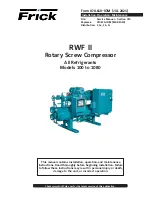
MAINTENANCE /
REP
AIR
TROUBLESHOOTING
OPERA
TION
ASSEMBL
Y /
INST
ALLA
TION
SAFETY /
SPECIFICA
TIONS
GETTING ST
AR
TED
6
PSI (Pounds per Square Inch)
- Measurement of the pressure exerted by the force of the air. The actual PSI output
is measured by a pressure gauge on the compressor.
SCFM (Standard Cubic Feet per Minute)
- Sometimes called CFM (Cubic Feet per Minute). Measurement of air
volume delivered by the compressor.
Air Delivery
- A combination of PSI and SCFM. The air delivery required by a tool is stated as (number) SCFM at
(number) PSI. The combination of these figures determines what size unit is needed.
Air Tank Capacity
- The volume of air stored in the tank and available for immediate use. A large tank allows the
intermittent use of an air tool with an air requirement higher than the compressor’s rated delivery.
Amps or Amperage
- A measure of the electrical force minus the resistance on an electrical line. This air
compressor requires 15 amps for operation. Be sure the compressor will operate on an electrical line with the proper
amps. If other appliances operate on the same line, they will reduce the available amps. If the amperage is not
adequate, the result will be blown fuses or tripped circuits.
Volts or Voltage
- A measurement of the force of an electrical current.
Cut-in / Cut-off Pressure
- Specific PSI at which a compressor starts and stops while refilling the air tank.
Regulator -
The regulator controls the amount of air pressure at the hose outlet. Turning regulator knob clockwise
(to the right) will increase air pressure at the outlet. Turning knob counterclockwise (to the left) will lower air
pressure to the outlet. Turning knob fully counterclockwise will shut off flow of air completely.
Handle
- Designed to move the compressor.
ASME Safety Valve -
This valve automatically releases air if the tank pressure exceeds the preset maximum.
Exhaust Tube
- This tube carries compressed air from the pump to the check valve. This tube becomes very hot
during use. To avoid the risk of severe burns, never touch the exhaust tube.
Check Valve -
One-way valve that allows air to enter the tank, but prevents air in the tank from flowing back into
the compressor pump.
Air Outlet
- A
quick connect coupler designed to work in combination with a quick connect plug to quickly and
easily join the compressor to an air hose.
GETTING TO KNOW YOUR COMPRESSOR (CONTINUED)
Pressure Gauges
- These gauges will show air pressure in the compressor tank and at the compressor outlet.
Outlet Pressure Gauge
- Will show air pressure at the outlet in pounds per square inch (PSI). Make sure this
gauge reads ZERO (by adjusting regulator knob fully counterclockwise) before changing air tools or disconnecting
air hose from outlet.
Tank Pressure Gauge
- Will show air pressure in tank while the compressor is running, indicating compressor is
building pressure properly. This gauge will show maximum pressure of compressor when it shuts off automatically
at the pressure switch.
Drain Valve
- This valve is located underneath the tank. Use this valve to drain moisture from the tank daily to
reduce the risk of corrosion.
Reduce tank pressure below 10 PSI, then drain moisture from tank daily to avoid tank corrosion.
Drain moisture from tank by opening the drain valve located underneath the tank.
Drain liquid from tank daily.









































